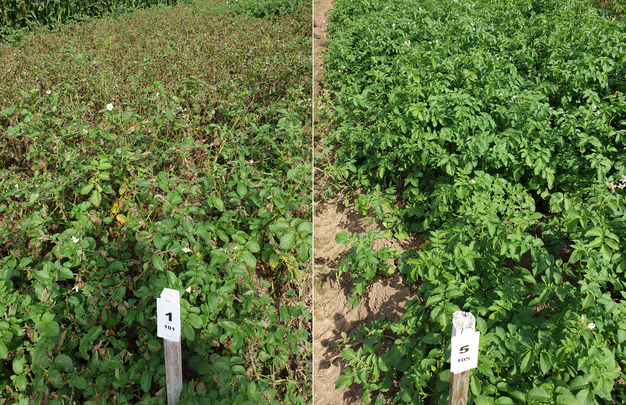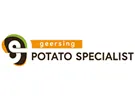Last season, Dutch organic ware potato yields were normal. Still, not all were sold as organic; some were marketed as conventional. Conventional table potatoes were in short supply, so prices, fortunately for organic growers, were good. "You wouldn't have wanted this year's mainstream prices to be low, too. At least, with these prices, organic growers can cover their costs," begins Jan-Eric Geersing. He expects more of the same for the upcoming season.
"Unless there's another significant phytophthora outbreak. Conventional potato prices are higher than all of last season. Those may fall slightly, but we know they'll stay good. If the organic harvest is normal, it'll be a repeat performance."
Johan Groen, Marcel Geersing, Jan-Eric Geersing en Marien Verhulst
The Dutch breeder understands that organic growers prefer selling their products as such, but sales are challenging. The price they get hardly differs from conventional, while supermarkets sell organic and mainstream potatoes at different prices. That hinders the organic market's growth. "There are enough organic potatoes. Then, it's a shame when purchases are hindered because that big price difference remains. Now is precisely the time to market more organic potatoes," says Jan-Eric.
"Don't market them as conventional, but sell them in the supermarket for the same price. Then, more people can learn about organic potatoes. Or make the entire ware potato market, which isn't that big anyway, entirely organic. With the current pressure on organic, I think we have more to gain from making certain parts of the market organic. That has more potential than the 15% organic farming by 2030 goal. That won't work with the market as it is."
Covenant
In 2017, on Bionext's initiative, growers, trading houses, and supermarkets struck a deal to accelerate the development of robust potato varieties. Supermarkets' organic shelves were to be entirely filled with resistant varieties. When the agreement ended in 2020, that goal had been largely achieved. In 2022, they renewed the deal, which will run until 2026. Because many Dutch potatoes go across the border, too, there must be support for these varieties there.
"There's strong cooperation between the Netherlands and Belgium, where a similar covenant is in place. Wallonia does business with northern France, where there are plans for such a deal. The United Kingdom is also working on something similar. Germany, though, is a very tricky story. They're still very much attached to spraying with copper sulfate; you daren't denounce it, even for organic products," Jan-Eric explains.
Resistant varieties
As a breeder and trading company, Geersing Potato Specialist is heavily involved in creating phytophthora-resistant varieties. "People talk about robust varieties, but we prefer saying phytophthora-resistant varieties because that robustness consists mainly of that resistance. These varieties have something to offer in the future, so we think it's vital that they're highlighted and their opportunities widened. With the current pressure, that interest is growing." Jan-Eric says there are now some 30 phytophthora-resistant varieties. A dozen come from Geersing Potato Specialist. "Many are still in development," he says.
 Agria (affected) and Cammeo (nog affected)
Agria (affected) and Cammeo (nog affected)
“We have 50 hectares of our biggest variety, Cammeo, so we'll be entering the market in full force. We also have two new types that are going strong: Camillo and Peter Pan. Camillo is in the Cammeo line, which grows a little larger and is earlier. Peter Pan is totally different; it's more of a German, yellow-fleshed, waxy potato. We've never found phytophthora in this very special variety, not even in years when the pressure got so high that resistance was broken. We now have 2.5 hectares of Camillo seed potatoes and half a hectare of Peter Pan. Camilo, we can already market; Peter Pan has to wait another year. There's plenty of interest, but we want to set up its propagation first and only then market it."
Phytophthora-resistant varieties are not, by definition, solely being developed for the organic market. "A variety only for the organic sector isn't a viable option in the Netherlands. It makes sense that there's more interest from the organic front because they have no way of controlling this disease. That's why that sector often takes the first steps. Resistant varieties that have been on the market for some time are now bigger in conventional than organic," says Geersing.
Aggressive fungal disease
A breeder's biggest fear is that the resistance and, thus, the trait that makes the variety unique is lost. With phytophthora as an adversary, that danger is great. Under the right conditions, this fungal disease can spread and mutate rapidly. "Phytophthora is so aggressive that you must use some form of control to protect that resistance adequately. It takes us ten to 15 years to create a new variety, and phytophthora can mutate significantly in a season and negate that resistance. You can never breed against that. That's why I think it's unfortunate that the covenant doesn't yet include biological agents. Growers have to incinerate plants as soon as phytophthora shows up. If you don't do that right away, the phytophthora that's broken through the resistance can develop further."
"That's the last thing you want. For a breeder, it's paramount that that resistance remains in place. Especially if that resistance is also a unique trait that makes the variety what it is. If the variety is no longer resistant, it's no longer sufficiently distinct from other varieties. Then, you simply lose that variety. You may have benefited from that resistant variety for a decade or so, but you must start all over after that. And it takes decades to breed that resistance anew into a variety. Growers know this, but ultimately, it's all about money. And I get that; I can't blame growers for that. Cultivating for a week longer can mean growers lose much-needed income. So we shouldn't assume growers will burn their plants as soon as they detect phytophthora," Jan-Eric admits.
Most breeders bet on gene-stacking, where they breed multiple resistant genes into a single variety. But that is risky. "WUR researcher Geert Kessel points out that by the time you’ve stacked genes, chances are some of those genes have also been broken, so they're ineffective. We work with two resistance genes in our varieties. In some years, there's tremendous phytophthora in susceptible varieties.
"The pressure can get so high that you can last five or six weeks longer, but the resistance breaks anyway. That's often temporary, and that resistance will be in place again in the new season. But suppose that particular phytophthora survives the winter in, say, a compost heap; then you've lost your resistant gene. That's why we want to see the use of agents as resistance management in the covenant. Those agents may not yet be available, but they're in development," Jan-Eric concludes.
Jan-Eric Geersing Geersing Potato Specialist B.V.
Geersing Potato Specialist B.V.
Banterweg 10
8302 AC Emmeloord
Tel: +31 (0)6 10537192
[email protected]
www.geersingpotatospecialist.com
